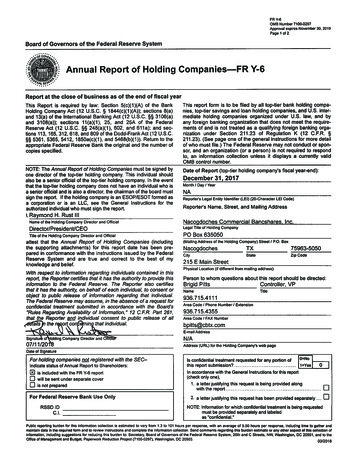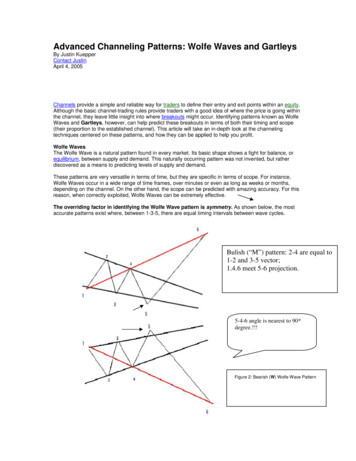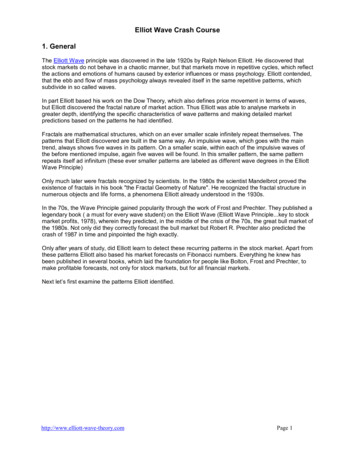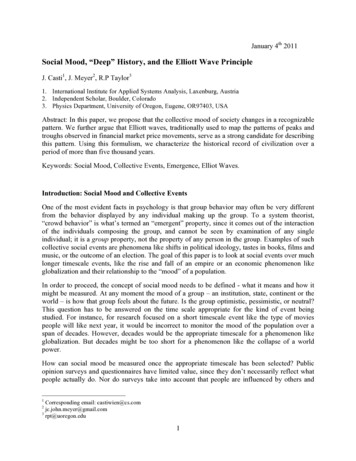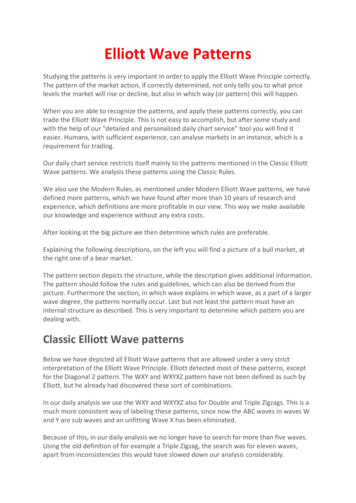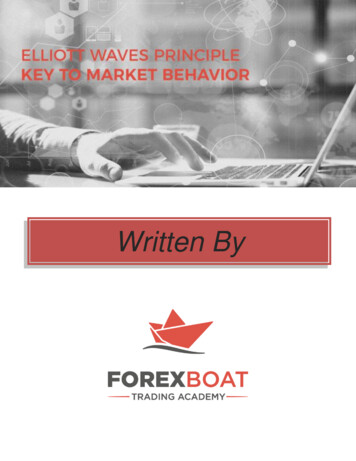
Transcription
Written By
2Table of ContentsDISCLAIMER .4Introduction .5What are the Elliott Waves? .5What Makes an Impulsive Move? .7Types of Impulsive Waves .8Third Wave Extensions .9First Wave Extensions .10Fifth Wave Extensions .11What Makes a Corrective Move? .12Simple Corrections .12Complex Corrections .13Where to Start the Count? .14Conclusion .15ForexBoat Trading Academy Elliott Waves Principlehttps://www.forexboat.com
3Copyright ForexBoat 2018, All Rights Reserved. The right of ForexBoat Pty Ltd to be identifiedas the author of the Work has been asserted him in accordance with the Copyright, Designs andPatents Act 1988. All Rights Reserved. No part of this publication may be reproduced, ortransmitted in any form or by any means, electronic or otherwise, without written permissionfrom the author.ForexBoat Trading Academy Elliott Waves Principlehttps://www.forexboat.com
4DISCLAIMERForexboat Pty Ltd (ABN: 29 609 855 414) a Corporate Authorised Representative (AR No.001238951) of HLK Group Pty Ltd (ACN: 161 284 500) which holds an Australian FinancialServices License (AFSL no. 435746). Any information or advice contained on this website isgeneral in nature only and does not constitute personal or investment advice. We will notaccept liability for any loss or damage, including without limitation to, any loss of profit, whichmay arise directly or indirectly from the use of or reliance on such information. You should seekindependent financial advice prior to acquiring a financial product. All securities and financialproducts or instruments transactions involve risks. Please remember that past performanceresults are not necessarily indicative of future results.ForexBoat Trading Academy Elliott Waves Principlehttps://www.forexboat.com
5IntroductionTechnical analysis has changed over time, as has trading. Even though traders mostly followrobots today, some things have remained the same. The Elliott Wave Principle key to marketbehavior is one of them. Elliott Waves look at markets from a human nature point of view. Assuch, the Elliott Wave Principle allows traders to catch perfect trades.Ralph Elliott was convinced that a hidden order exists in the financial markets. He didn’t wastehis time. Instead, he built a system that comprises the market’s reactions as a result of humanbehavior.To this day, “Elliotticians” label/count waves according to the Elliott Waves Theory. They usethe same rules for various markets, but Elliott developed the trading theory for the stockmarket.However, it doesn’t matter, because human nature is the same. As such, the Elliott WavePrinciple works on all financial markets.Speed and volatility surround today’s markets, especially the Forex market.Yet, Elliott Waves works under these same conditions. What Elliott did was to lay down therules of a logical process to understand market behavior.He strongly believed that market and human behavior are the same. One is the result of theother.Therefore, the Elliott Wave rules and the overall theory represent a road map to humanbehavior. To this day, the Elliott Waves Principle is one of the most complex trading theoriesthat exist. If not, the most complex one.Throughout history, human behavior has been a big unknown. And it still is.To try to order financial markets movements under a set of rules is no easy task. Yet, Elliott didit.The rules that make the Elliott Waves are both logical and precise. As a result, Elliott Wavepredictions have a great degree of accuracy.What are the Elliott Waves?Elliott’s final book called “Nature’s Law – The Secret of the Universe” introduced his findings tothe world.ForexBoat Trading Academy Elliott Waves Principlehttps://www.forexboat.com
6In his efforts to understand the market, Elliott started from a basic concept. The market movesin waves.He divided the waves into two main categories: impulsive and corrective ones. But there wasstill something missing. How to connect them?How to find the link between the two? The answer came from the markets’ cyclical nature.As such, Elliot Waves consider different cycles of different degrees, and a cycle has both animpulsive and a corrective wave.Any Elliott Wave trader knows that an impulsive wave has five waves of a lower degree which isa so-called five-wave structure.However, a corrective wave has only three. Because of that, an Elliott Wave cycle shows a fivewaves market decline or advance, corrected by the other three waves.To count an impulsive wave, Elliott used numbers and he used letters for a corrective wave.As such, a bullish or bearish cycle has a 1-2-3-4-5- a-b-c count. These eight waves form theElliott Wave Principle key to market behavior.ForexBoat Trading Academy Elliott Waves Principlehttps://www.forexboat.com
7Elliott stressed the importance of understanding the market cycles. They make the Elliott WavePrinciple look like a complex theory. And, in reality, it is.The idea is to integrate the impulsive and corrective waves into the right cycle. But this is themost difficult thing to do.As a result, many traders fail at correctly counting the waves. Where does a move start? Wheredoes the correct count start?What Makes an Impulsive Move?An impulsive wave is a five-wave structure. As mentioned earlier, Elliott used numbers to countthe waves: 1, 2, 3, 4, and 5.But one thing is important here. All five waves make an impulsive wave of a bigger degree.These five waves can be the first wave of an impulsive wave of a bigger degree. Or, the thirdwave. Or the fifth one. It may be even the first part of a corrective wave.To complicate things even further, not ALL five waves show impulsive activity. Only the first, thethird and the fifth one.ForexBoat Trading Academy Elliott Waves Principlehttps://www.forexboat.com
8Also, depending on the nature of the a-b-c correction, both waves A and B might be impulsive.Here are the rules of an impulsive move according to Elliott Waves: The first wave is an impulsive wave. It has five waves of a lower degree.The second wave represents corrective activity. The correction is either a simple or acomplex one.The third wave is an impulsive wave as well, and, it cannot be the shortest of theimpulsive waves of the same degree. Namely, when compared with waves 1 and 5, thethird can’t be the shortest one.Wave 4 shows a correction. Like the second wave, it is either a simple or a complex one.The fifth wave is impulsive too.Waves 2 and 4 should not overlap.This five-wave structure makes an impulsive wave.On top of the above rules, the Elliott Waves Principle states that: No parts of the second wave should go beyond the start of the first.In an impulsive move, at least one wave must extend.The two corrective waves must differ.Types of Impulsive WavesDividing the market moves into impulsive and corrective waves wasn’t enough. While itrepresents a great starting point, it is just that. It is only a starting point.Elliott found that in an impulsive activity, at least one wave must extend. But what is anextension?Once again, as in all major trading theories, the Fibonacci numbers/ratios come to help. As arule of thumb, an extended wave is 161.8% bigger than the previous one.The extended wave is always the one that stands out of the crowd. Simply look for the longestone.An Elliott Wave Indicator MT4 Platform will automatically plot the extension. However, evenwithout it, any trading platform makes it easier to find it thanks to the Fibonacci Expansion tool.ForexBoat Trading Academy Elliott Waves Principlehttps://www.forexboat.com
9Third Wave ExtensionsThe most common wave to extend is the third wave. In fact, out of all impulsive waves themarket forms, third wave extensions form most of the time.Naturally, the third wave is the longest in the five-wave structure. And, it is an impulsive waveon its own. Just of a lower degree.Elliott Wave predictions in an impulsive wave consider opening a trade when the second waveretraces. To be more exact, when the second wave retraces 50%-61.8% of the first wave,traders go long. That is if the impulsive wave is bullish.Obviously, they go short on a bearish trend. Finding the entry is an easy task. This time, tradersuse the Fibonacci Retracement tool.Because the Elliott Wave Principle says the second wave can’t travel beyond the start of thefirst wave, traders use this as a stop. Hence, in a bullish move, they buy the 61.8% dip with astop at the full retracement.For such a trade, they target a 161.8% extension of the first wave. But, projected from the endof the second wave.ForexBoat Trading Academy Elliott Waves Principlehttps://www.forexboat.com
10The extended level represents the minimum distance the price must travel. This is one of thereasons that make the Elliott Wave Principle key to market behavior.However, in strong impulsive waves, the price travels much more than that. Here’s how anElliott Wave theorist would short a currency pair.First, traders look for the 61.8% retracement. That’s the selling area.Second, the stop loss is at the start of the first wave. Finally, the extended level gives the takeprofit. Perfect setup, great trade.First Wave ExtensionsAfter the 3rd wave extensions, the 1st wave ones come next. Logically, the first wave is thelongest one.Not only is it the longest, but the Elliott rules give the limits for the other ones. Let’s put themtogether one by one.If the first wave extends (is the longest), but the third wave can’t be the shortest, this makesthe fifth wave the shortest. Again, such limitations give the stop loss to any trade that mightresult.When the 1st wave extends, the second wave doesn’t retrace by 61.8%. It barely reaches38.2%. As such, traders that want to open a trade must find other conditions to set the stoploss.ForexBoat Trading Academy Elliott Waves Principlehttps://www.forexboat.com
11The distance until the start of the first wave is simply too large.Fifth Wave ExtensionsThis type of impulsive waves are the rarest ones. When they form, the fifth wave is the longestone. The one that stands out of the crowd.Elliott found only a couple of instances when this impulsive wave appears. Because of that,whenever this kind of impulsive wave forms, the market retraces the fifth wave almostcompletely.Besides the three types of impulsive moves mentioned here, there’s one other. A doubleextended impulsive move.ForexBoat Trading Academy Elliott Waves Principlehttps://www.forexboat.com
12When this one forms, both the third and the fifth wave extend. Namely, the third wave’s lengthis 161.8% bigger than the first wave and the fifth wave extends when compared with the thirdone.But, this seldom happens. The third wave extension makes the Elliott Wave Principle key tomarket behavior.What Makes a Corrective Move?If impulsive moves look complicated, think twice. Corrective waves are even more complex.The thing is that the market doesn’t trend very much. In fact, it spends most of the time inconsolidation.Therefore, corrective waves form most often. It is no wonder Elliott found multiple types ofcorrective waves.In his pattern recognition approach to corrective waves, Elliott used the same principle. Hedivided them into two categories. Simple and complex corrections.Simple CorrectionsHere, things look simple. Elliott identified only three simple corrections: a flat, a zigzag, and atriangle.But, the logical process is only the start. There are multiple types of triangles, zigzags, or flatpatterns.To put this into perspective, consider that Elliott found no less than ten types of flat patterns.Ten!A flat is an a-b-c, or a three-wave structure.Labeling it with letters shows its corrective nature. But only two waves are corrective. The cwave is a five-wave structure of a lower degree.The key to a flat and a zigzag is the golden ratio. That’s right, Fibonacci again.In fact, an Elliott Wave analysis is not possible without the Fibonacci ratios. As a rule, the bwave in a flat must retrace 61.8% beyond wave a.A zigzag is still an a-b-c. With some key distinctions:ForexBoat Trading Academy Elliott Waves Principlehttps://www.forexboat.com
13 Both waves A and C are impulsive.Wave B must NOT retrace beyond 61.8% of the 1st wave.The most interesting thing appears on triangles.First, they are the most common way for the market to consolidate.Second, they are called three-wave structures. But they have five legs. As such, labelingbecomes the following: a-b-c-d-e.Finally, all the legs of a triangle show corrective activity. All of them!In the example below, the triangle acts as a reversal pattern. When this happens, the marketexperiences a complex correction.Complex CorrectionsUnfortunately, simple corrections are not the most common ones. They don’t form oftenenough.This is especially true on the Forex market. Large swings and aggressive moves are the norms inthis industry.Again, Elliott split the waves. As such, the market may form a complex correction with a small xwave or with a large one.The idea of an x-wave is a brilliant one. It connects two simple corrections.ForexBoat Trading Academy Elliott Waves Principlehttps://www.forexboat.com
14Nowadays, any Elliott Wave Indicator displays the x-waves. Even the most basic Elliott WaveOscillator will do this.The key to a simple or complex correction stays with the x-wave and with its retracement level.For that, one Elliott Waves rule states that small x-waves can’t retrace beyond 61.8%, of thefirst correction!To identify that, traders use a Fibonacci Retracement tool. They drag it from the start until theend of the first correction.The Elliott Wave used by Forex traders shows the x-wave in multiple counts. That’s becausecomplex corrections form often.An interesting fact, the x-wave is a corrective wave on its own. Always.And, it can be either simple or complex. Elliott found various patterns that fit into complexcorrections with a small x-wave.Patterns like double and triple threes, or double and triple combinations, are just a few tomention. A small x-wave is their common element.Where to Start the Count?A major problem for many Elliott Wave international traders is the starting place for a count.Where to start the count from?The answer to this problem comes from approaching the market from a different perspective.Introducing the top/down analysis concept.The idea is to start a count from the biggest timeframe possible. Hence, the monthly chart.For markets with historical data, even better. Start from the very beginning.Next, look for the different timeframes to act as different cycles. Elliott Waves Principle calls forcycles of bigger degree that further divide into smaller ones.That’s what any modern trading platform does. As such, start from the monthly and continueinto the weekly time frames.ForexBoat Trading Academy Elliott Waves Principlehttps://www.forexboat.com
15When doing that, start on the weekly from where the count ended on the monthly. Thencontinue with the daily, four-hour and hourly charts.Some Elliott Waves traders go even lower. To five-minute charts, which is not recommended.The Forex market moves so fast that there’s no way to update the charts. Simply put, there isno time for it.This solves traders’ major riddles. Plus, it puts things in order.Part of trading success is to use a disciplined approach to trading. Such an approach makesElliott Wave Principle key to market behavior.ConclusionTo sum up, we can say without hesitation, that the Elliott Waves Principle is a great tradingtheory. When correctly applied, traders can corner a market.Unfortunately, Elliott laid down so many rules and conditions, that they are very difficult tofollow. Moreover, data differs from broker to broker.Because of that, traders often have different Elliott Waves interpretations of the same market!Some like to simply wait for the 61.8% retracement of a move. When this happens, theybuy/sell for the minimum extension. That’s called the market confirming the “litmus test”.Others like patterns more, and as such, they choose to trade only triangles.Since they form most of the time, they’re everywhere, on any timeframe and any currency pair.The point is that the Elliott Waves Theory has something for everyone. Firstly, it gives a sense ofdirection. Traders always know where they are and what to expect.That’s the very basic idea when trading. Making a forecast!Secondly, trading becomes disciplined. A stop loss and a target result easily from the analyticalprocess.Moreover, Elliott Waves is purely technical. Based on human behavior, the fundamental part isalready incorporated into the analysis.ForexBoat Trading Academy Elliott Waves Principlehttps://www.forexboat.com
16This is a powerful statement. Because of that, the Elliott Waves Principle is the most completetrading theory ever created. No other trading theory takes human nature so seriously.Finally, it is the only (meaning there’s no other!) trading theory that incorporates time into ananalysis. Namely, it gives traders the opportunity to target a level (price) in a specific amount oftime.Price and time are the holy grail of trading. But more on that on another occasion.See you in Class!The ForexBoat TeamForexBoat Trading Academy Elliott Waves Principlehttps://www.forexboat.com
Because of that, an Elliott Wave cycle shows a five-waves market decline or advance, corrected by the other three waves. To count an impulsive wave, Elliott used numbers and he used letters for a corrective wave. As such, a bullish or bearish cycle has a 1-2-3-4-5- a-b-c count. These eight waves form the Elliott Wave Principle key to market .

